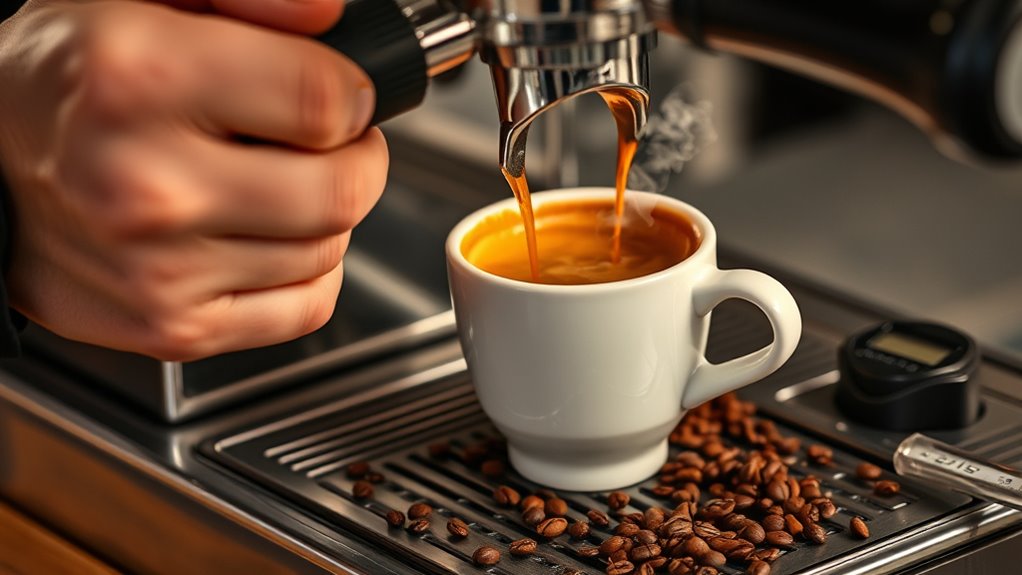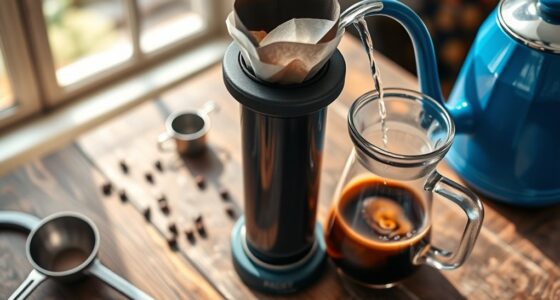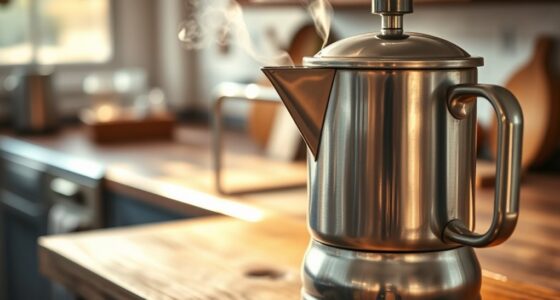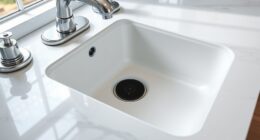To fix common coffee mistakes, start by adjusting your grind size—coarse for a flat taste, fine for bitterness. Check your water quality; filtered water often improves flavor, while mineral content affects extraction. Regularly clean your equipment to prevent buildup that hampers flow. Small tweaks in brewing time, temperature, and water can make a big difference. Keep experimenting with these simple fixes, as mastering them will bring you closer to that perfect brew you’re after.
Key Takeaways
- Adjust grind size to correct sour (coarser) or bitter (finer) flavors for better extraction.
- Use filtered water to improve flavor clarity and prevent mineral-related bitterness or flatness.
- Regularly clean and descale your equipment to ensure proper water flow and consistent extraction.
- Monitor brewing time and temperature, tweaking these alongside grind size for balanced flavor.
- Make small, incremental adjustments to variables for optimal brew quality and troubleshooting efficiency.
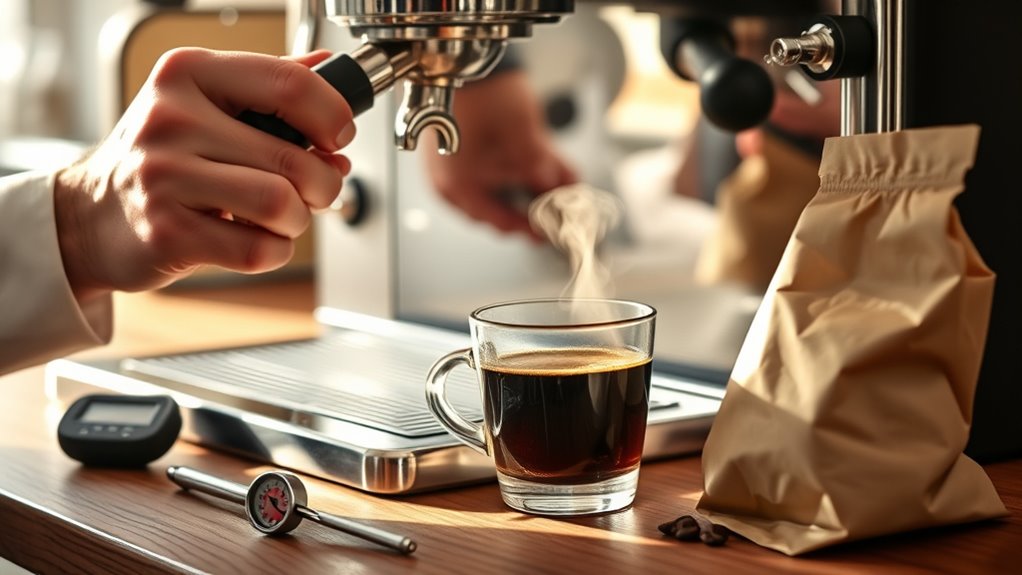
Ever wondered why your brew doesn’t turn out quite right? Sometimes, the culprit is as simple as adjusting your grind size or paying closer attention to your water quality. The grind size directly influences how your coffee extracts, affecting flavor, body, and clarity. If your coffee tastes weak or overly bitter, you might be using a grind that’s too coarse or too fine for your brewing method. For example, a coarse grind is ideal for French press, allowing water to flow through slowly, extracting rich flavors. Conversely, a fine grind suits espresso machines, where quick pressure pulls out concentrated shots. Experimenting with grind sizes can make a significant difference in achieving a balanced brew. Keep in mind, water quality also plays a vital role. Hard water, laden with minerals, can cause your coffee to taste flat or develop unwanted bitterness, while overly soft water might lead to under-extraction, resulting in a weak flavor. Using filtered or bottled water often yields a cleaner, more vibrant cup, as it minimizes impurities and mineral imbalances that interfere with extraction.
When troubleshooting your coffee, start by checking your grind size. If your brew is sour or acidic, try a slightly coarser grind; if it’s overly bitter or harsh, go finer. Adjusting your grind can be quick and cost-effective, often requiring just a few tweaks. Pair this with ensuring your water quality is ideal. Using water that’s too hard or too soft can mask subtle flavor notes or create off-flavors. Consider using filtered water or testing your water’s mineral content to see if it aligns with your brewing method. Many coffee enthusiasts recommend using water with a balanced mineral profile, roughly 150 mg/L of total dissolved solids, to optimize extraction. Additionally, GMC tuning techniques can be applied to optimize your equipment’s performance, ensuring consistent water flow and temperature during brewing.
Another common mistake is neglecting to clean your equipment regularly. Residual oils and mineral buildup can obstruct water flow and influence extraction, leading to inconsistent results. Regularly descaling your coffee maker and cleaning your grinder will help maintain the integrity of your brew. Also, pay attention to your brewing time and temperature, as these factors work in tandem with grind size and water quality to produce the perfect cup. If your coffee is consistently off, revisit these basics first. Small adjustments often yield noticeable improvements, making your brewing process more forgiving and enjoyable. With a little patience, you’ll be able to identify the right grind size and water quality that turn your everyday brew into a perfect cup.
Frequently Asked Questions
How Can I Tell if My Coffee Grind Size Is Correct?
You can tell if your grind size is correct by observing your coffee’s extraction and consistency. If it’s too bitter or sour, your grind might be off—too fine or too coarse. A proper grind size guarantees even extraction, giving you balanced flavor. You should notice a consistent texture, free of clumps or uneven particles, which helps improve your brew’s overall taste. Adjust the grind size until your coffee flows smoothly and tastes right.
What’S the Best Way to Clean My Coffee Maker?
Cleaning your coffee maker is simple and satisfying. Start by descaling with a mixture of vinegar and water to remove mineral buildup, which also tackles coffee stain removal. Run the brew cycle, then rinse thoroughly with clean water. For stubborn stains, use a gentle brush. Regular cleaning prevents clogs, preserves flavor, and prolongs your machine’s life. Keep your coffee fresh and flavorful with these simple, systematic cleaning steps.
How Do I Adjust Brewing Time for Better Flavor?
To adjust brewing time for better flavor, start by experimenting with your coffee maker’s settings. Increasing the brew time allows for more thorough flavor extraction, resulting in a richer brew, while reducing it can prevent over-extraction that makes your coffee bitter. Keep track of your adjustments to find the perfect balance for your preferred brew strength. This way, you control the flavor profile and enjoy a more satisfying cup every time.
Why Is My Coffee Brewing Too Slowly?
Ever wonder why your coffee takes forever to brew? It could be due to a low brew temperature or filter clogging. When the water isn’t hot enough, it slows extraction, making the process longer. A clogged filter restricts water flow, causing delays. To fix this, increase your brew temperature slightly and clean or replace your filter regularly. These simple steps help speed things up for a smoother, faster brew every time.
Can Water Quality Affect Coffee Taste and Troubleshooting?
Water quality definitely affects your coffee’s taste. If your water has high mineralization, it can alter flavor and cause scaling in your equipment. Using filtration systems helps remove impurities and balance mineral content, resulting in better-tasting coffee. Troubleshoot by testing your water and considering filters that reduce unwanted minerals. This way, you guarantee your brew is smooth, consistent, and free from off-flavors caused by poor water quality.
Conclusion
Just like a master barista refines their craft, you can perfect your brew with patience and attention. Remember, every mistake is a step toward better coffee—think of it as turning your kitchen into your own alchemist’s lab. Keep experimenting, stay curious, and don’t be afraid to tweak your process. Soon, you’ll be brewing up magic every morning, proving that even the greatest coffee legends started with a simple mistake.
